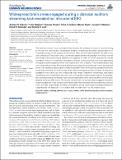Widespread Brain Areas Engaged during a Classical Auditory Streaming Task Revealed by Intracranial EEG
Author(s)
Dykstra, Andrew Richard; Halgren, Eric; Thesen, Thomas; Carlson, Chad E.; Doyle, Werner; Madsen, Joseph R.; Eskandar, Emad; Cash, Sydney S.; ... Show more Show less
DownloadDykstra-2011-Widespread Brain Areas Engaged during a Classical Auditory.pdf (2.094Mb)
PUBLISHER_POLICY
Publisher Policy
Article is made available in accordance with the publisher's policy and may be subject to US copyright law. Please refer to the publisher's site for terms of use.
Terms of use
Metadata
Show full item recordAbstract
The auditory system must constantly decompose the complex mixture of sound arriving at the ear into perceptually independent streams constituting accurate representations of individual sources in the acoustic environment. How the brain accomplishes this task is not well understood. The present study combined a classic behavioral paradigm with direct cortical recordings from neurosurgical patients with epilepsy in order to further describe the neural correlates of auditory streaming. Participants listened to sequences of pure tones alternating in frequency and indicated whether they heard one or two “streams.” The intracranial EEG was simultaneously recorded from sub-dural electrodes placed over temporal, frontal, and parietal cortex. Like healthy subjects, patients heard one stream when the frequency separation between tones was small and two when it was large. Robust evoked-potential correlates of frequency separation were observed over widespread brain areas. Waveform morphology was highly variable across individual electrode sites both within and across gross brain regions. Surprisingly, few evoked-potential correlates of perceptual organization were observed after controlling for physical stimulus differences. The results indicate that the cortical areas engaged during the streaming task are more complex and widespread than has been demonstrated by previous work, and that, by-and-large, correlates of bistability during streaming are probably located on a spatial scale not assessed – or in a brain area not examined – by the present study.
Date issued
2011-08Department
Harvard University--MIT Division of Health Sciences and TechnologyJournal
Frontiers in Human Neuroscience
Publisher
Frontiers Media S.A.
Citation
Dykstra, Andrew R. et al. “Widespread Brain Areas Engaged during a Classical Auditory Streaming Task Revealed by Intracranial EEG.” Frontiers in Human Neuroscience 5 (2011).
Version: Final published version
ISSN
1662-5161